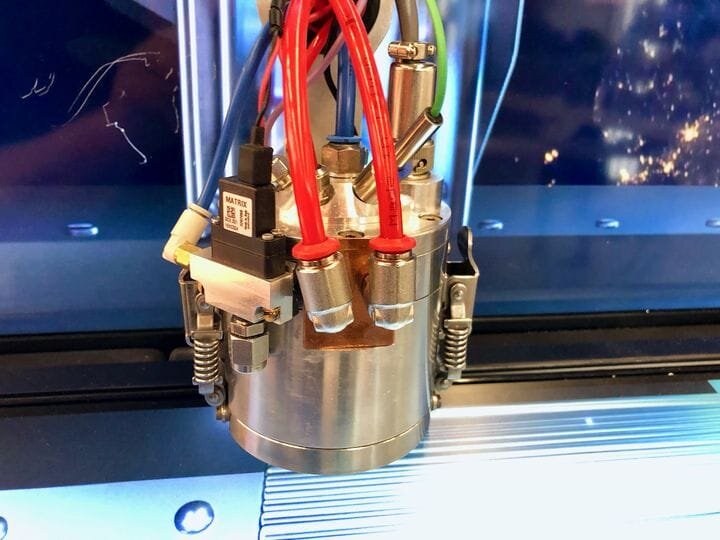![Toolhead for the ValCUN metal 3D printing process [Source: Fabbaloo]](https://fabbaloo.com/wp-content/uploads/2020/05/image-asset_img_5eb08cda0be9b.jpg)
ValCUN, a Belgian startup, has produced a new metal 3D printing process I’ve never seen previously.
Powder Metal 3D Printing
Metal 3D printing is a highly complex matter involving precise control of temperatures, energy, atmosphere, materials and process. The typical powder bed / laser approach is well-understood and can produce high quality, certifiable parts, but incredibly expensive to operate.
This is primarily due to the powder materials involved. Loose metal powder is toxic, able to be instantly contaminated with oxygen or water, messy and occasionally explosive, meaning strict handling regimes must be employed, including comprehensive facility air controls.
Why use powder? It’s largely because of the properties of metals. Unlike plastics, which have a softened state in which they can be extruded and molded, metals tend to transform immediately from solid to liquid form, making it challenging to do anything other than casting. Meanwhile, powder remains stationary while lasers or electron beams can solidify it (and sometimes microwaves, too).
DED 3D Printing
One alternative approach has been to use direct energy deposition, or DED, in which a wire is positioned at the appropriate point in 3D space and a laser or other energy source melts the tip of the wire for deposition. However, this usually requires an expensive multi-axis robot to position the toolhead. Thus direct melting of metals has typically been a small market.
ValCUN Process
Now ValCUN has developed a rather unique method of achieving metal deposition in a form quite similar to filament extrusion, and it’s actually quite straightforward. Here’s how it works:
-
Metal pellets, wire or even scraps are inserted into the machine
-
The hot end raises the temperature of the input metal to its melting point, transforming the material to a liquid
-
The liquid metal is “extruded” through a high temperature ceramic nozzle (apparently made by ADMATEC)
-
As the liquid metal leaves the nozzle, it instantly cools and solidifies
-
The nozzle moves about within the X-Y space of a layer depositing material
-
Subsequent layers are built in the same manner as filament 3D printers to complete the object
ValCUN Metal Cooling
This seems very straightforward, but I am certain the question you are asking is, “how does the liquid metal cool so quickly”, and “Would it not slop all over?”
This is the magic developed by ValCUN. They have created an incredibly precise material flow and speed ratio that is able to allow the material to solidify essentially as soon as it leaves the nozzle, much like a thermoplastic would do. Basically they manage the temperature of the material so precisely it freezes at just the right moment.
Their extrusion system, pictured at top, includes a mysterious mechanism for controlling flow. ValCUN explained that it is not gravity dependent, meaning the deposition tool could potentially be used in a variety of configurations, including a robotic arm where objects could be built from all angles.
However, their goal is to be able to 3D print with the same characteristics as normal FFF 3D printing, up to 300mm/s deposition.
ValCUN Benefits
![Aluminum ingots usable in the new ValCUN metal 3D printing process [Source: Fabbaloo]](https://fabbaloo.com/wp-content/uploads/2020/05/valcun-aluminum-1_img_5eb08cda614b0.jpg)
There are a number of benefits to the ValCUN system.
One is that the process can take place in open air without the need for atmospheric control as is required by powder systems. How is this achieved? Apparently the deposition uses a curtain of argon gas around the liquid metal. Thus argon would be a consumable for their process.
The ValCUN process is material independent; it should work for any metal or alloy, as long as it can melt. Their current experiments involve aluminum, simply because it has a relatively low melting point to ease experimentation. However, they will soon begin work on copper, and will even be able to 3D print multiple materials.
One startling result of ValCUN’s experiments is that bridging is possible! Bridging is the act of extending an extrusion over a gap without material underneath. This is commonly done in thermoplastic extrusions, but shocking to see when depositing a liquid metal. This demonstrates how precise their control over temperatures can be.
The major benefit of the process is likely to be cost savings. Fine metal powder is spectacularly expensive, up to US$500/kg for some material types, leading to extreme costs for prints made with powder. Meanwhile, ValCUN’s process can easily make use of commonly available raw metal at 10% of the cost of powder.
![Metal scrap from CNC milling usable in the new ValCUN metal 3D printing process [Source: Fabbaloo]](https://fabbaloo.com/wp-content/uploads/2020/05/image-asset_img_5eb08cdaa5d33.jpg)
Even better, they can also make use of scrap material at even lower costs. For example, they explained they could purchase a tonne of scrap aluminum for only €150 (US$165), dropping the price of 3D printing considerably.
For now they are still refining the concept and do not expect to come to market with products until some time in 2021. However, they are accepting test business cases from interested parties at this time.
Via ValCUN

